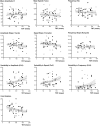Impact of Prolonged Temporal Discrimination Threshold on Finger Movements of Parkinson's Disease
- PMID: 27893840
- PMCID: PMC5125668
- DOI: 10.1371/journal.pone.0167034
Impact of Prolonged Temporal Discrimination Threshold on Finger Movements of Parkinson's Disease
Abstract
Introduction: Sensory information is essential for the precise control of movement. Patients with Parkinson's disease (PD) have higher-order sensory dysfunctions including prolonged temporal discrimination threshold (TDT). However, the impact of prolonged TDT on parkinsonian motor deficits is uncertain.
Methods: This study includes 33 PD patients and 24 healthy controls. TDT values were measured in the index finger. Using coin rotation task (CRT), dexterous finger movement was assessed. Using an inertial sensor, the speed, amplitude, and frequency of finger tapping were measured. The impact of prolonged index finger TDT on two different finger movements was analyzed using the general estimating equation.
Results: Compared to healthy controls, TDT was prolonged in the PD patients. There was no impact of TDT on mean values or decrement for amplitude and speed, as well as mean values, decrement and variability of tapping frequency. However, prolonged TDT had a significant impact on the variability in amplitude (B = 436.905 × 10-4, Wald χ2 = 9.140, p = 0.014) and speed (B = 425.655 × 10-4, Wald χ2 = 9.876, p = 0.014) of finger tapping. There was a marginal correlation between TDT and CRT. In addition, CRT correlated with variability in amplitude and speed of finger tapping.
Conclusion: In PD, cutaneous temporal discriminative sensory dysfunction appears to be related to increased variabilities in the speed and amplitude of fast repetitive finger movements and disturbed finger dexterity.
Conflict of interest statement
The authors have declared that no competing interests exist.
Figures



References
-
- Koller WC (1984) Sensory symptoms in Parkinson's disease. Neurology 34:957–959. - PubMed
-
- Wolpert DM, Ghahramani Z, Jordan MI (1995) An internal model for sensorimotor integration. Science 269:1880–1882. - PubMed
-
- Artieda J, Pastor MA, Lacruz F, Obeso JA (1992) Temporal discrimination is abnormal in Parkinson's disease. Brain 115:199–210. - PubMed
Publication types
MeSH terms
LinkOut - more resources
Full Text Sources
Other Literature Sources
Medical
Research Materials

